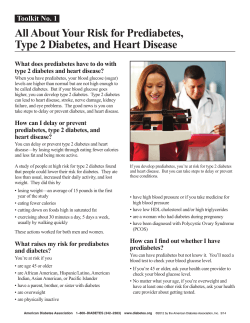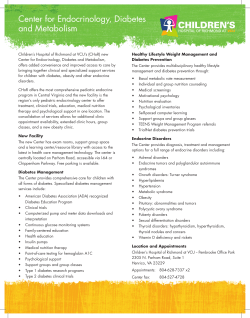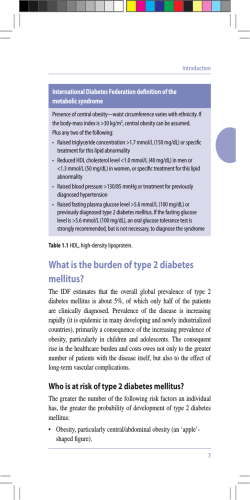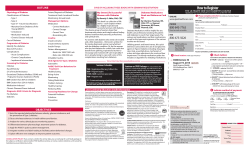
Using the Behavior Score Dashboard
Using the Behavior Score Dashboard Tracking behavior change and patient progress has just become simpler. AADE has worked with diabetes educators, behaviorists, and measurement experts to develop Behavior Score Tools that will allow you to measure and track individualized behavior change. These tools are free to practicing diabetes educators (DEs) who are members of AADE and available at a minimal annual fee for all diabetes educators. The Behavior Score Dashboard (BSD) was designed to support three major objectives: 1. A beginning (an ongoing) conversation with patients to examine all areas of diabetes management that are key to their success 2. A tool that provides the framework for how diabetes education and training are to be addressed in the practice setting 3. A means of measuring both patient progress and professional practice outcomes. The 2011 rollout of the Behavior Score Dashboard is predominately targeting the first objective and teaching diabetes educators (DE) how to use it. As a stand-alone instrument, as part of the Patient Self-Assessment Initial Patient Self-Assessment, or as part of a systematic approach (example, AADE7 System™), in its current form the BSD is a robust tool that provides DE with an evidence based, data collection tool that can used to initiate DSME/T then track care planning and patient progress. The BSD also addresses the second and third objectives by providing the potential for a standardized approach to patient assessment for Diabetes Self-Management Education / Training. Capturing actual performance measures and linking to health outcomes will be dependent on the specific delivery system in which the DE practices. How to Use the Behavior Score Dashboard with Patients The BSD can be used in patient care to: 1. establish a plan of care that fully involves the patient 2. be used as a reference to discuss patient efforts and progress 3. help the person with diabetes see change over time 1 There are 21 core questions (3 for each behavior) in the BSD. These questions have also been integrated into the AADE Patient Self-Assessment Initial Patient Self-Assessment and AADE Follow-up Patient Self-Assessment. Many DEs currently assign the AADE Patient Self-Assessment Initial Patient Self-Assessment to the people with diabetes to whom they provide services. The Patient Self-Assessments can be assigned directly through the AADE7 System™ or downloaded as hard copy (A downloadable Spanish Version of the Patient Self-Assessment Initial Patient Self-Assessment is also made available from the AADE7 System™ Document Center) that can be provided to the person with diabetes when they attend the first DSME/T session. If a DE assigns the AADE Initial and Follow-up Self-Assessment to all those receiving DSME/T, he/she will not need to use the stand-alone version of the BSD. Hence, the remainder of this document will not be relevant. Instead, the DE will wish to read the User Guide for the AADE Patient Self-Assessment. Instructing the Person with Diabetes in Completing Questions in the Behavior Score Dashboard The dashboard has been designed to be colorful, interactive and provide “instant” information. Once completed, scores are immediately visible and can guide the way to creating a plan with the patient. The Behavior Score Dashboard is not an end point. Rather it allows the person with diabetes to set the agenda for the discussion while staying focused on the critical self-management behaviors. The first step is to give the person with diabetes an opportunity to respond to the questions about the seven behaviors. Before they begin, instruct them that there are no ‘right’ or ‘wrong’ answers. Also explain that they will have other opportunities to discuss their answers, as their “scores” are just the starting point towards building their own customized plan. If the person with diabetes will be responding to the BSD by computer, take a few moments to make certain s/he is logged on and understands how to respond to the questions and how to use the computer! Let them know that they are going to be selecting a number for each question that best represents what is happening right now, not what they hope will be happening in the future. Again, assure them that there are no ‘right’ or ‘wrong’ answers. Someone should be close at hand to help the person with diabetes work through the BSI if they need help. And before they log off of the computer, review the questions quickly to be sure that all were answered. Since the focus is on engaging the patient’s attention and involvement, it is suggested that you print off a copy to use during the time with the person with diabetes (and maybe even a color copy for the patient, if you think this would be helpful at that point). 2 Reviewing the Behavior Score Dashboard to Plan Care Sit with the person with diabetes and review the questions and their answers. Get the ‘big picture’ view of all seven (7) behaviors before focusing in on only one. The questions themselves are opportunities to explore and better define the education/training issues that the person with diabetes might be ready to address. Where there are low scores that indicate the behaviors are difficult to do or maintain, ask the person with diabetes about their experiences in that/those areas. A leading question might be: “I see that you scored this low. Can you tell me more about why you see this as a low score area?” “What has been your experience in managing (food, activity, monitoring, etc.)?” Where scores indicate that the person with diabetes perceives him/herself as doing well with maintaining that set of behaviors, ask them how they got to that point. It at all possible, emphasize the positive and create an environment of success (no matter how modest). Let the person with diabetes know how this can positively affect overall diabetes management. After discussing the patient’s scores, the next step is to configure the information into a plan. The educator’s function is to help the person with diabetes see how the behaviors fit together to support improved glycemic control and diabetes management, and then s/he begins the work of crafting a plan of self-management that fully utilizes the patient’s involvement. At this point, the educator may move into their own approach or style of education, but they are doing so using the BSI as a framework of the key areas that need to be addressed. This is also where the diabetes educator’s expertise and skills are fully utilized to determine how to proceed to best help that individual patient. Even if the plan starts small, the BSI information can be used to identify some short term and intermediate goals, and the DE and person with diabetes together can determine how best to get there. Next Steps – Use of the BSD in On-Going Self-Management Education / Training The BSD can be used at subsequent patient – educator sessions, perhaps as a starting point to reconnect, and focus on that session’s agenda. Referring back to the Plan activities, the BSI can also be referenced to see if perceptions and/or behaviors are changing. In this way, it can be a helpful tracking device. So, should person with diabetes “retake” the BSI at every visit / encounter? Behavior change – real behavior change – takes time, and the behavior has to be maintained for at least six weeks to have any beginning confidence that new behaviors are being established. To ask the person with diabetes to repeat the BSI earlier than three months, is not likely to be helpful, and can even slow progress if the person with diabetes gets frustrated and downhearted. The BSI can serve as a guide, but it should not be over-administered so that it loses the core intent which is to help the person with diabetes “see” ways and possibilities to be successful in areas that are central to successful diabetes management. 3
© Copyright 2026





















